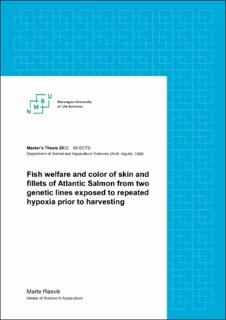| dc.contributor.advisor | Mørkøre, Turid | |
| dc.contributor.advisor | Våge, Dag Inge | |
| dc.contributor.advisor | Torgersen, Jacob Seilø | |
| dc.contributor.author | Røsvik, Marte | |
| dc.date.accessioned | 2022-12-14T12:29:19Z | |
| dc.date.available | 2022-12-14T12:29:19Z | |
| dc.date.issued | 2022 | |
| dc.identifier.uri | https://hdl.handle.net/11250/3037701 | |
| dc.description.abstract | Oxygen is a fundamental necessity for the fitness and survival of Atlantic salmon. Hypoxia is reduced access to oxygen and low levels of oxygen in body tissues, which affects the welfare, immune response, and product quality of Atlantic salmon. The severity of hypoxia is dependent on exposure time, the size of the fish, life stage and genetics. In the present study, two genetic lines that were selected for fillet color alone (RED and PALE), were exposed to repeated hypoxia (one, two or three times) and the effects on biometric parameters, welfare, skin color, fillet color and fillet quality were evaluated.
The body weight, condition factor, and fillet yield of the PALE genetic line was higher compared to the RED genetic line, and hypoxia had no effect on these biometric parameters. The cardiac somatic index of the RED genetic line was higher compared to the PALE genetic line, and hypoxia had no effect. The operational welfare indicators were all affected by exposure to repeated hypoxia. Most of the indicators were not affected by genetics, however the snout damage score was higher for the RED genetic line compared to the PALE genetic line. The fillet color was redder and the astaxanthin content was higher for the RED genetic line compared to the PALE genetic line, but hypoxia did not negatively affect the fillet color. The skin of NQC got darker and less blue with exposure to repeated hypoxia. The skin color of anterior fillets was not affected by hypoxia. The fillet texture got softer as the fish were exposed to repeated hypoxia.
Genetics affect color and biometric traits, and hypoxia negatively affects welfare and darkens the skin color of NQC. There needs to be more research that covers the interaction between heart health and astaxanthin retention. In conclusion, further research is needed to look at the performance and mechanisms behind the differences between the two genetic lines. The astaxanthin retention and disposition could be genetically linked to biometric traits and heart health and could be a potential topic suitable for further research. | en_US |
| dc.description.abstract | Oksygen er essensielt for Atlantisk laks sin velferd og overlevelse. Hypoksi er redusert tilgang til oksygen og lave nivåer av oksygen i kroppsvev, som påvirker velferd, immunrespons og produktkvalitet hos Atlantisk laks. Alvorlighetsgraden av hypoksi varierer med hvor lenge fisken er eksponert, fiskestørrelse, livsstadiet og genetikk. I denne studien ble to genetisk ulike linjer som var selektert kun for farge (RED og PALE), eksponert for hypoksi (en, to eller tre ganger) og effekten på biometriske parameter, velferd, hud og fillet farge, og fillet kvalitet ble evaluert. Kroppsvekten, filletvekten, kondisjonsfaktor, filletutbytte og kardiosomatisk indeks for den bleke genetiske linjen (PALE/BLEK) var høyere sammenlignet med den røde genetiske linjen (RØD/RED), og hypoksi hadde ingen effekt på de biometriske parameterne. Alle de operative velferdsindikatorene ble påvirket av eksponering av gjentakende hypoksi. De fleste operative velferds indikatorene ble ikke påvirket av genetikk, bortsett fra den RØDE genetiske linjen som hadde høyere skåring på snuteskade sammenlignet med den BLEKE genetiske linjen. Fillet fargen var rødere for den RØDE linjen sammenlignet med den BLEKE linjen. Skinnfargen på NQC ble mørkere og mindre blå med mer eksponering for hypoksi. Skinnfargen på den fremre fileten ble ikke påvirket av hypoksi. Filetteksturen ble mykere ved eksponering av gjentakende hypoksi. | en_US |
| dc.description.sponsorship | Norwegian University of Life Sciences, AquaGen, FHF | en_US |
| dc.language.iso | eng | en_US |
| dc.publisher | Norwegian University of Life Sciences, Ås | en_US |
| dc.rights | Attribution-NonCommercial-NoDerivatives 4.0 Internasjonal | * |
| dc.rights.uri | http://creativecommons.org/licenses/by-nc-nd/4.0/deed.no | * |
| dc.title | Fish welfare and color of skin and fillets of Atlantic Salmon from two genetic lines exposed to repeated hypoxia prior to harvesting | en_US |
| dc.type | Master thesis | en_US |
| dc.subject.nsi | VDP::Landbruks- og Fiskerifag: 900 | en_US |
| dc.description.localcode | M-AA | en_US |

